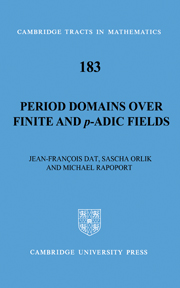Book contents
- Frontmatter
- Contents
- Preface
- Introduction
- Part 1 Period Domains for GLn over Finite Fields
- Part 2 Period Domains for Reductive Groups over Finite Fields
- Part 3 Period Domains over p-adic Fields
- VIII PERIOD DOMAINS OVER p-ADIC FIELDS
- IX PERIOD DOMAINS FOR p-ADIC REDUCTIVE GROUPS
- X COHOMOLOGY OF PERIOD DOMAINS OVER p-ADIC FIELDS
- Part 4 Complements
- References
- Index
X - COHOMOLOGY OF PERIOD DOMAINS OVER p-ADIC FIELDS
from Part 3 - Period Domains over p-adic Fields
Published online by Cambridge University Press: 02 December 2010
- Frontmatter
- Contents
- Preface
- Introduction
- Part 1 Period Domains for GLn over Finite Fields
- Part 2 Period Domains for Reductive Groups over Finite Fields
- Part 3 Period Domains over p-adic Fields
- VIII PERIOD DOMAINS OVER p-ADIC FIELDS
- IX PERIOD DOMAINS FOR p-ADIC REDUCTIVE GROUPS
- X COHOMOLOGY OF PERIOD DOMAINS OVER p-ADIC FIELDS
- Part 4 Complements
- References
- Index
Summary
In this chapter we consider the compactly supported étale ℓ-adic cohomology of period domains. We will write down in the basic case a recursive formula for the Euler–Poincaré characteristic in a Grothendieck group of JF(ℚp)-representations (possibly infinite-dimensional ones). Once again, we use the Langlands Lemma to resolve the corresponding recursion formula. The general argument is essentially the same as for finite fields, but the representation theory of p-adic reductive groups is somewhat different from that of finite reductive groups. We start with a review of the necessary background on smooth representations of p-adic groups.
Generalized Steinberg representations
In this section, we let G denote a reductive group over ℚp. In contrast to the first two parts of this book, where representations of finite groups were considered, we are interested here in smooth representations of G(ℚp) on vector spaces over the field. Here smooth means that the stabilizer of any vector has to be open in G(ℚp). Such representations are generally infinite-dimensional, but we do not need to consider any topology on the underlying vector space. They form in an obvious way an abelian category Rep∞(G(ℚp)).
We note that the subcategory of finitely generated objects is much bigger than that of finite length objects (unless G is anisotropic). Moreover, both subcategories are known to be abelian, but the canonical map between their Grothendieck groups is far from being injective, see.
- Type
- Chapter
- Information
- Period Domains over Finite and p-adic Fields , pp. 303 - 316Publisher: Cambridge University PressPrint publication year: 2010



